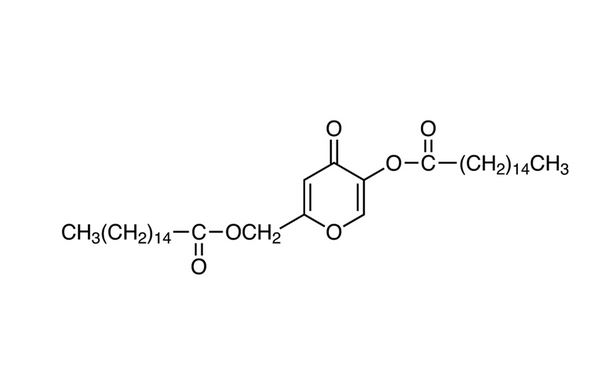Why kojic acid dipalmitate?
Kojic acid dipalmitate is a derivative of kojic acid and a fatty acid (palmitic acid), and one of the many active we use to alleviate the problem of hyperpigmentation.

Figure. Kojic acid dipalmitate
Sometime ago, may be our skin was uniformly pigmented, but as soon as we got our first suntan, that perfection was gone. Small areas appeared that were more heavily pigmented than others. Why? Because synthesis and accumulation of melanin in the skin is an exquisitely complicated mechanism which is easily disrupted. When disrupted, hyperpigmentation ensues.
There are many ingredients that can be used to help with hyperpigmentation and this is a good example of when not to go for harsh “treatments”. Skin that is prone to hyperpigmentation is likely to react to many types of stress with more hyperpigmentation. For example, hydroquinone, a chemical used for skin lightening but banned in many countries because of its many side effects, will often result in more hyperpigmentation. Laser used to eliminate hyperpigmentation can result in larger spots that persist months after the treatment.
Kojic acid is used in cosmetics for its skin lightening effect. Kojic acid dipalmitate is a derivative of kojic acid and a fatty acid (palmitic acid). This chemical modification makes it more stable, oil soluble and less irritating to the skin.
Chemical names often have an historic root; at the beginning of the 20th century kojic acid was isolated from “koji” (malted rice). Nowadays, kojic acid is produced by fermentation of carbohydrate by Aspergillus oryzae. In Japan kojic acid is present in a variety of food and drinks that involve fermentation in their production.
Other useful properties of kojic acid are its antifungal abilities and its capacity to chelate heavy metals.
I prefer to use kojic acid dipalmitate as one active of many, because hyperpigmentation is best approached as the multi-step process that starts when UV reaches the skin and culminates in the accumulation of melanin in the keratinocyte. This synergistic approach allows us to use lower concentrations of each active so that we get better results in less time and with no side effects.
